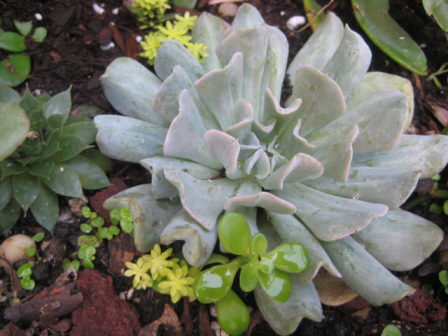Soft Succulents That Are Easy to Handle

Succulent plants can help create unique yard settings.
Jeff Moore spoke to the San Diego Horticultural Society about succulents that “do NOT draw blood.” While succulents is not a scientific term, it has come to mean fleshy plants that store moisture. Many of these have such pretty leaves that flowers are unnecessary to enhance your garden. Best of all, Moore says succulents have the “will to live,” which is always a good thing for a desired plant in a garden.
Succulents have another advantage for us: our climate. Most succulents prefer a dry climate without too much moisture, which is their leading cause of death. Most dislike extreme cold and hate snow. Some do poorly in extreme heat as well. Whereas San Diego County is nearly ideal for succulents, many are happy growing anywhere from the Mexican border to San Francisco.
Aeoniums are a type that does not do well in dry areas. Too intense heat or too much direct sunlight may kill them, but they also do not do well if they get wet and then it is cold. If it has been raining and it is cold, you might want to keep pots of sensitive plants indoors and perhaps covered to conserve warmth.
Although technically succulents are part of the cactus family, most people consider succulents as non-cactus plants. Succulents fall into a few genera: Aeoniums (usually thin leaved rosettes on a stalk that dislike excess moisture), Echevarias, Crassulas, Sedums, Kalanchoes, Dudleyas, Senecios, Cotyledons, Memsebs, and Stapeliads. Moore says even after 25 years of owning a succulent nursery, he still cannot identify all succulents.
It may be age, he says, but there are so many varieties, many of which have made-up names. In fact, one grower of Echevaria hybrids confessed that he only names the healthiest and best of the hybrids he creates. Since he cannot bear to throw away the others, he gives them un-named to nurseries. Often if you wait until the plant blooms, the flowers will give you a clue to its origins. To identify a plant as a succulent as Jeff Moore does, step on it or run over it; succulents will always leave a wet spot. He includes Plumeria in the succulent category.
Most succulents propagate easily. Some regrow from a cut-off portion of the plant stuck it in the ground. Jade is a good example. Many have “pups” which are small plants found around the mother plant. The pups will grow into adult plants and have babies of their own. Those that grow from seed are much harder to propagate. Some Dudleyas and Echevarias only grow from seeds. One form of kalanchoe is known as “mother of millions” since it is almost invasive. “Succulents are the lazy gardener’s friend,” says Moore.
Your garden can be a work of art. A great benefit to succulents is that their leaves are often more attractive than their flowers. Leaves range from almost white to yellow to all shades of green, from red- tipped to all red or burgundy. Their shapes differ: rosettes may sit nestled together on the ground while others grow on tall stems. Some form ground cover; some trail over a wall or a pot’s side. That is another virtue of succulents: they can be happy in the ground or in a pot. They can also be planted on a wall to resemble a mural or a painting. This vertical garden is more of a challenge. The plants do not stay neatly clumped together as they were planted. Some grow leggy. After a few years they need to be re-planted in the ground soil where they will thrive having devoted a portion of their lives to the art world.
Moore says that people who are really focused on a particular species or genus will fill their pots with the same kind of succulent. These pots can come from anywhere: wheelbarrows, mailboxes, old sinks, toilets, wine casks, a broken chair are just some of the possibilities. Artier gardeners prefer to use shape, texture and color to create oeuvres d’art. Whether you are using a pot of as garden or are creating a garden within your landscape, you still can create a visual statement. Rocks and gravel can enhance your landscape. Walls may do so as well.
If you live where the heat can go to triple digits, you might plant your succulents in the shade giving them get just enough early sun to keep their colors vibrant. Succulents in pots need cactus or succulent soil, which is light and drains quickly. Although they enjoy getting wet, they like to dry out between being watered. In winter they may not need watering at all. During Santa Anas or dry spells, they may need a weekly shower.
Moore likes to correct for our alkaline water with a tablespoon of distilled white vinegar in five gallons of tap water.
Moore is casual about feeding his succulents. Whatever they eat, it is half-strength. He says otherwise it’s like putting them on steroids — not a good thing. He only feeds when he thinks it’s necessary or if the plant looks stressed. To correct for our alkaline water fertilizer, add a tablespoon of distilled white vinegar in five gallons of tap water to their diluted fertilizer.
Moore’s books are beautiful and contain a wealth of information and a plethora of gorgeous photographs. His nursery is Solana Succulents in Solana Beach. It is worth the trip.
Our next meeting is September 26 at the Mission Hills Nursery, located at 1525 Fort Stockton Drive. Our Fiscal year ends this month so it would be a good time to renew your membership. Go to our website at MissionHillsGardenClub.org for information on upcoming events: coffees, wines, or teas in various gardens, meeting topics, and miscellaneous information.
Category: Education, Entertainment, Events, feature, Local News







